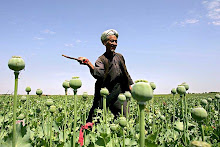
Foremost in the minds of the international community these days is the Karzai government. Allegations of corruption are on the rise. It is alleged that Karzai’s own brother, Wali, is involved in the opium trade. Karzai is also facing criticism for his alliances with warlords. It would be interesting to see how Karzai addresses the concerns of the international community over the corruption charges leveled at him. In a recent television interview Karzai denied allegations of corruption against top government functionaries.
There are more than 100,000 North Atlantic Treaty Organisation (NATO) and US-led troops stationed in Afghanistan at present, fighting the most serious Taliban insurgency since the Taliban regime was toppled eight years ago. Back in Washington, President Barack Obama is mulling over sending 40,000 more troops to Afghanistan.
Opium and the illicit trade of opiates – specifically heroin – have to be seen in this context. More than nine-tenths of the opium market worth $ 65 billion is flooded with Afghan opium according to UN findings. The rampant corruption and lawlessness inside Afghanistan, and the porous borders in the surrounding regions, ensure that only two percent of the opium is seized locally.
According to the UN, world-wide, opium takes 100,000 lives annually. In NATO member states alone, 10,000 people die of Afghan heroin. This is five times the number of NATO troops killed in action in Afghanistan since 2001. The worst affected is Russia, with 30,000 deaths annually. This is more than the Soviet deaths during USSR’s intervention in Afghanistan in 1979-1989.
These figures are indicative enough of the seriousness of the issue. There is little doubt that the struggle to uproot opium cultivation from the Afghan soil is as important as uprooting the Taliban if not more. The consequences of opium are certainly more insidious and devastating to society than terrorism. 
There is further impetus to controlling drug trade in Afghanistan. Flush with drug money generated through direct involvement and taxing opium farmers in the regions under their control, the Taliban is slowly acquiring a war machine which is becoming technologically more complex, according to the UN report. The report also estimates that the Taliban has hoarded about 12,000 tons of Afghan opium.
In this grim situation there is a ray of hope. Afghan Opium Survey 2009 estimates that =opium cultivation in Afghanistan decreased from 157,000 hectares in 2008 to 123,000 hectares this year, a drop of 22%. The number of provinces free from opium cultivation has increased to 20 from 18 previously. The mix of carrot and stick policy and favourable terms of trade for legal crops coupled with introduction of “food zones” for the promotion of licit farming appears to be showing positive results. Along with this, the drop in opium prices due to over-supply at the source and low market penetration, especially in European markets, has started tilting the balance against opium cultivation.
These are good signs. A sustained targeting of real criminals instead of poor Afghan farmers and sincere efforts to eradicate poverty in the country would go a long way in bringing stability to the region. There is much to be accomplished on this front.











